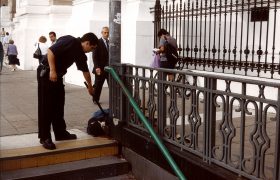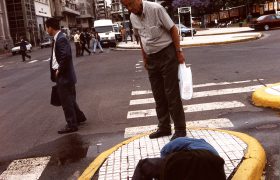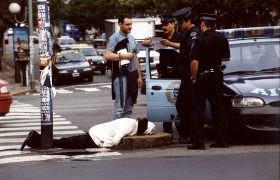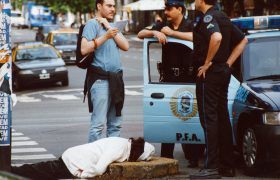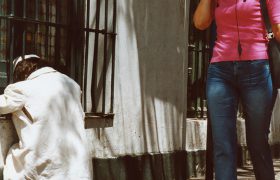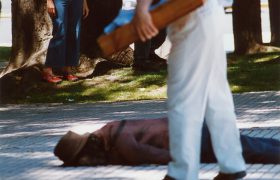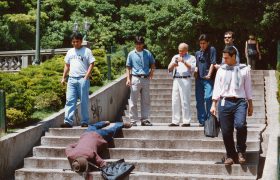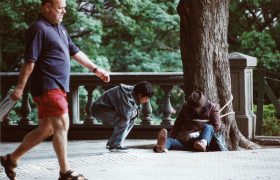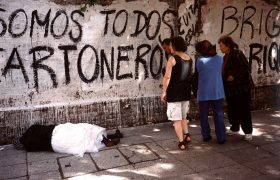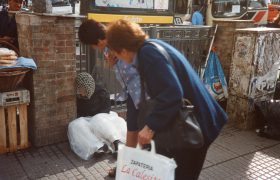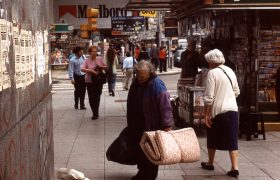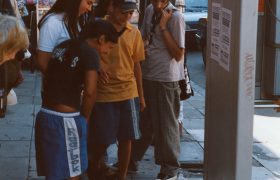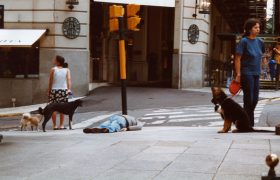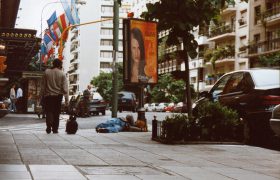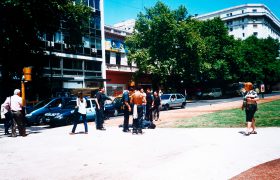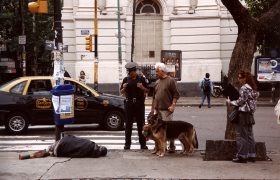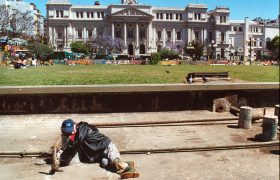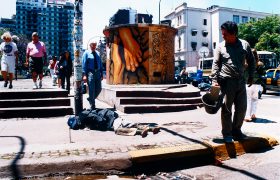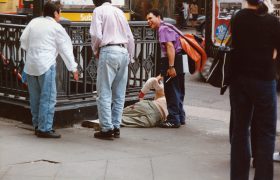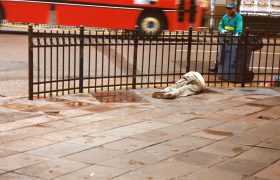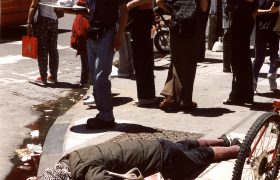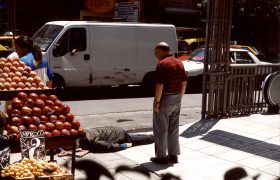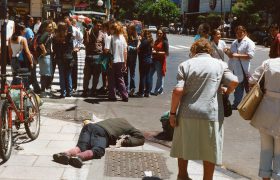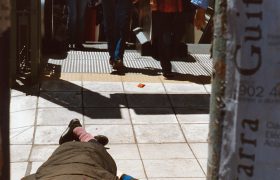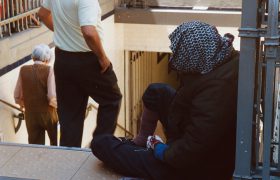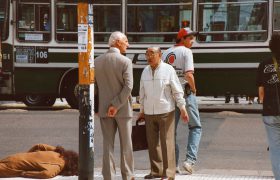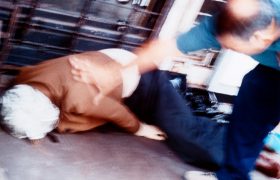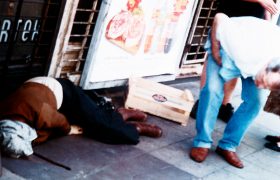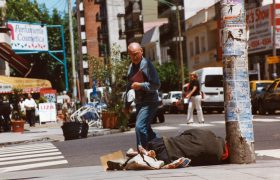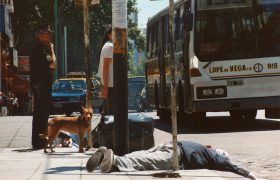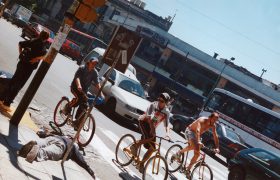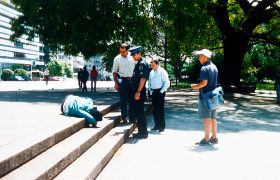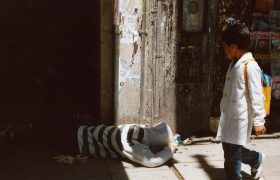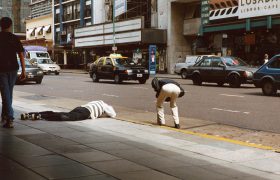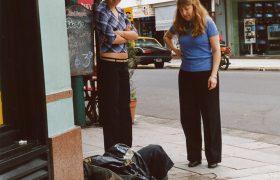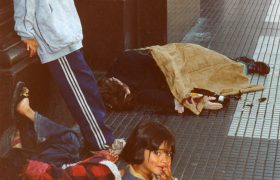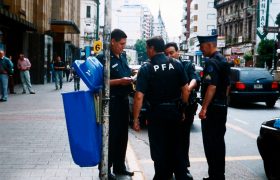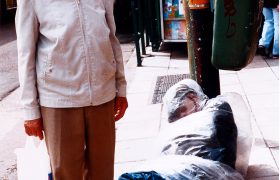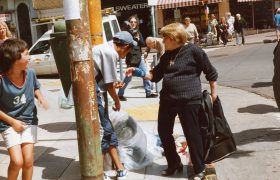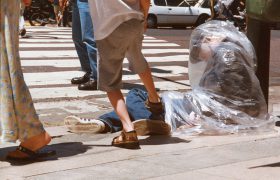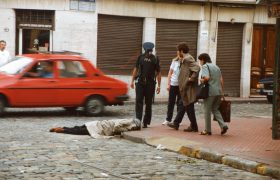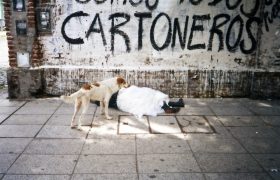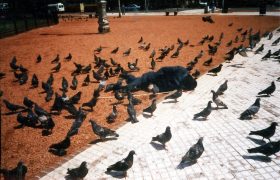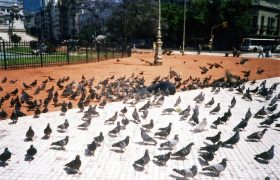November 15th 2002
Buenos Aires – Argentina
On November 15th 2002, in collaboration with the Centro Cultural Rojas under the direction of Fabián Lebenglik, a second edition of the Proyecto Filoctetes took place in the city of Buenos Aires. Students from the different workshops the institution offers participated in the seminar and the urban intervention. The sociologist Horacio González, the historian and art critic María Teresa Constantini, and the writer and playwright Luis Cano were among the special guests invited to reflect on the experience. The performance took place between 9 am and 3 pm. Once again, the project was met with controversy and shock. The project got featured in the print and TV media. The first edition, which included images depicting the experience, got published. It included critical essays and testimonies. A month later, a public debate and an exhibition of the documental material previously selected during the seminar took place at the same cultural center.
Lemnos in Buenos Aires
November 15th 2002. Buenos Aires, Argentina
Universidad de Buenos Aires / Centro Cultural Ricardo Rojas
Director Fabián Lebenglik
Concept & Creation: Emilio García Wehbi
Documentation & Production: Maricel Alvarez
Design of puppets: Norberto Laino
Assistant: Julieta Potenze
Producers (Centro Cultural Ricardo Rojas): Martín Tufro, Hernán Casabella
Guests: Luis Cano, María Teresa Constantin, Horacio González
Workshop participants
Tamara Ajzensztat, Margarita Antonini, Elizabeth Arjona, Leonardo Belvedere, Alejandro Berón Diaz, Florencia Bié, Pablo Bologna, Danna Caldara, María Laura Campolongo, María Florencia Carrasco, Margarita Ciarlotti, Luciano Cocciardi, Gabriel Cohen Falah, Silvina Crespo, Lía Dansker, Lidia De Faveri, Nelly Del Valle Benes, Gabriela Escobar, Carlos Eduardo Spíndola, Diego Fernández, María Figueras, Paula Frachia, Gustavo Fredes, Héctor Miguel Gallardo, Alvaro Gorbato, Javier Grosso, Laura Librandi, Luisa Fernanda Lindo, Carlota Lores, Maximiliano Dante Maggiori, Gustavo Alejandro Makrucz, Jorge, Ignacio Martin, Carla Mizzau, Pablo Luis Molina, Cristian Montes, Diego Javier Oriola, Romina Paula, Gabriel Hernán Pecot, Eduardo Pérez Winter, María José Queiro, Amalia Retamozo, Francisco Ricci, Talía Rico, Pablo Alejandro Richard’s, Marisol Rivas Pérez, Soledad Rodriguez, Pablo Sebastián Rojas, Marta Inés Ruiz, Fernando Sánchez, Ezequiel Steinman, Mariana Stizza, Sabrina Torres, Noralí Venini, Julieta Wiedemann, Ignacio Zabaleta.
Locations
- Federico Lacroze Ave. & Corrientes Ave.
- Scalabrini Ortiz Ave. & Corrientes Ave.
- Abasto shopping mall
- Corrientes Ave. & Lavalle Str.
- Callao Ave & Corrientes Ave.
- General San Martín Theatre
- Palace of Justice
- Congressional Park
- La Prensa building, the House of Culture
- Paseo Colón Ave. & Belgrano Ave.
- Defensa Str. & Estados Unidos Str.
- Córdoba Ave. & Florida Str.
- San Martín Square
- San Martín Square II
- Alvear Ave. & Schiaffino Str.
- Village Recoleta Cinemas
- Houssay Square
- Botanic Garden
- Cabildo Ave. & Juramento Ave.
- Triunvirato Ave. & Monroe Ave.
- Cuenca Str. & Nazarre Str.
- J.B. Justo Ave. & San Martín Ave.
- Acoyte Ave. & Rivadavia Ave.
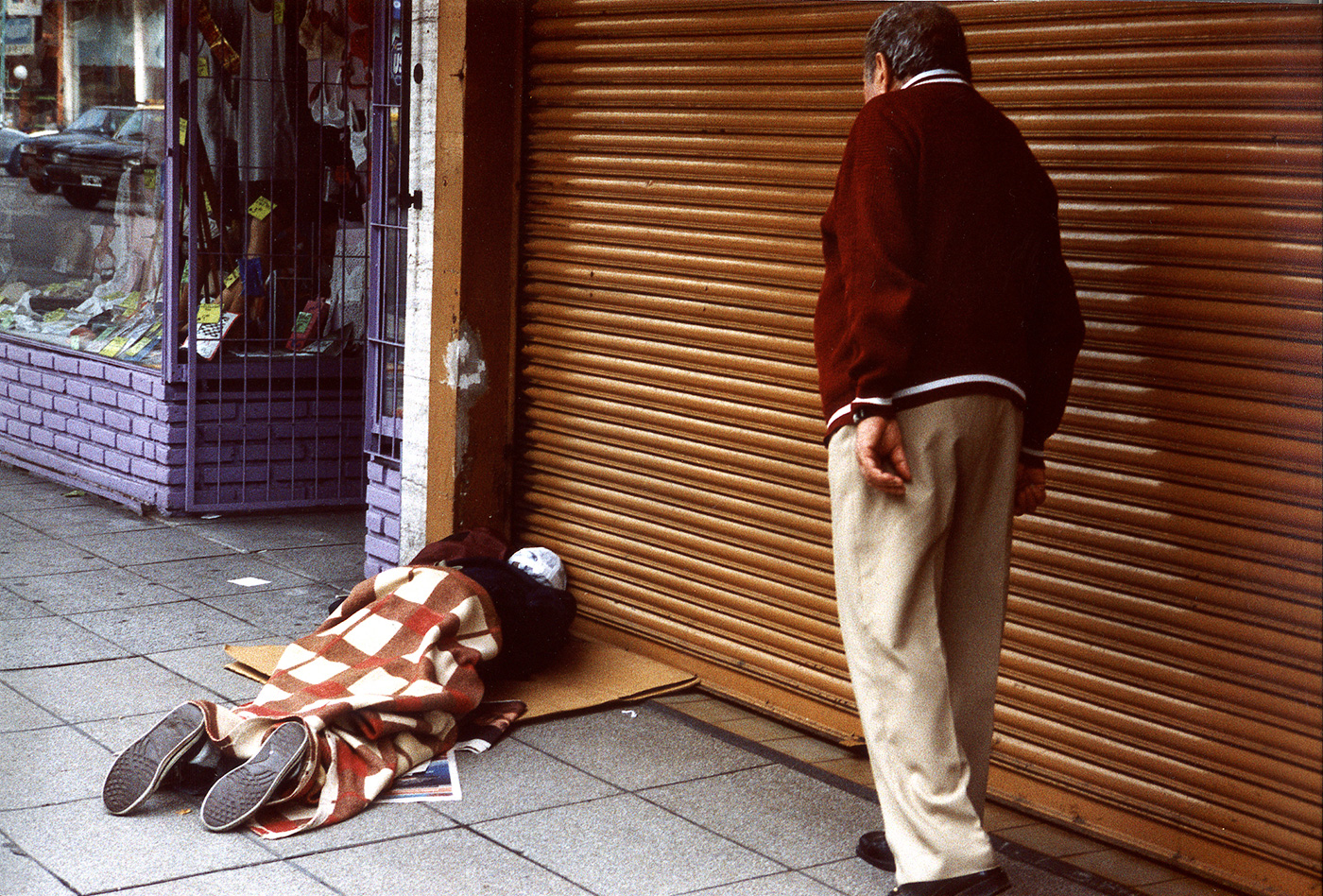
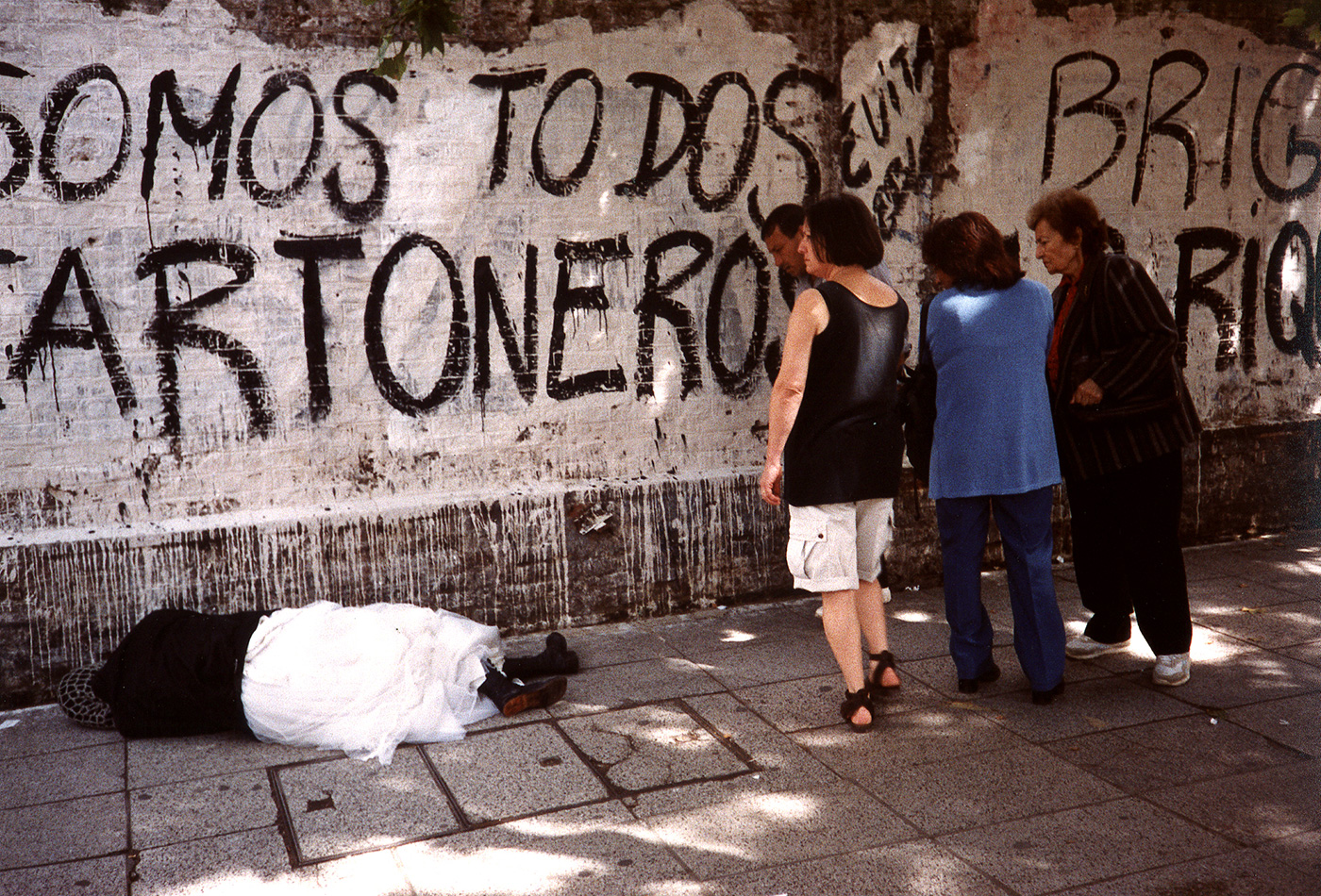
“Proyecto Filoctetes belongs to contemporary theater, the philosophy of marionettes, urban casual art, dramaturgical enquiries about moral actions and the political controversy with regards to the situation of the abandoned body in the anonymity of the city. It involves a startling action, a complex planning process, it challenges mass media and explores the horizons of tolerance or reaction when confronted by the broken lives that dwell in every big metropolis.”
(Horacio González, Letter to Maricel Alvarez & Emilio García Wehbi)
“We could say that ‘piqueteros’ (picketers), ‘cartoneros’ (cardboard scavengers), the new poor and unemployed that appeared in Argentina from December 2001 onwards are the Filoctetes, the new phármakos that community spaces need so others can be saved. The ritual figure of phármakos seems to fulfill these ‘purgative’ functions, societies have always had this anthropophagic vocation: one side devours the other, vomits its waste where it is more or less visible and then has the good taste of considering any gesture that intends to return its gaze on to its own detritus as violent.
(Ileana Diéguez, "Teatralidades invisibles, intervenciones liminales ¿políticas de lo incorrecto?")
“Reality is so troubled nowadays, social tension is so high, that García Wehbi’s art aimed to escape the walls that envelop it to reach a wider audience. So, for Proyecto Filoctetes, the whole city is viable and every passer-by is at once a spectator and an actor. It is no longer a matter of a forewarned audience seeking art out, here art takes the audience by assault. When the effect of bodies on the street provoked and shocked spectators, many questioned the intervention as an artistic act and many complained that if it was art it should be performed in a museum. The anger and questioning of the intervention is understandable and even anecdotal, but the truth is that the irruption of the doll violates the privacy of the passer-by, shakes their perception and invades them. Therein resides its inquisitive and revulsive power and also its healing power.”
(María Teresa Constantin, "Cuerpos padeciendo. Emilio García Wehbi y Filoctetes: Lemnos en Buenos Aires")
